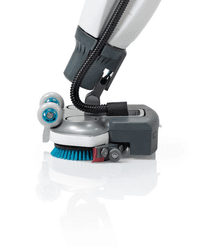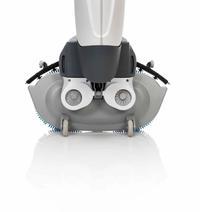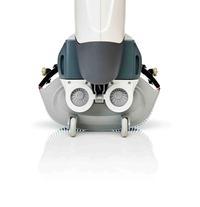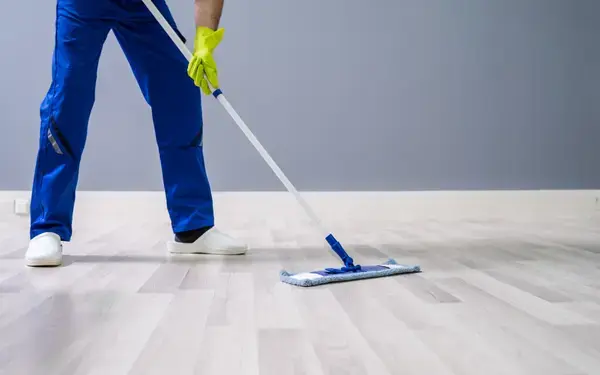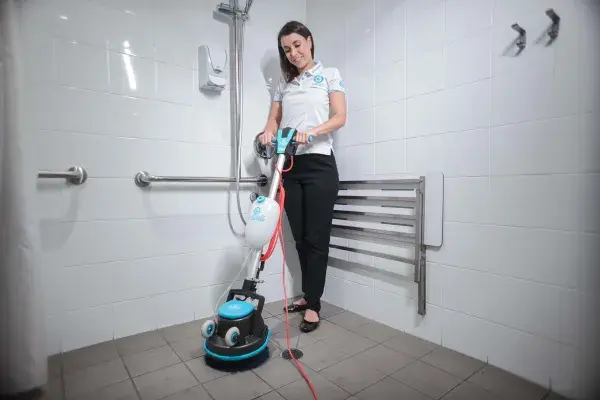You are reading: Walk-Behind vs Ride-On Floor Scrubbers: The Maneuverability Showdown
25 June 2025
7min read time
Brooke Payne
Walk-Behind vs Ride-On Floor Scrubbers: The Maneuverability Showdown
Share:

Key Insights
- Maneuverability Directly Impacts Labour & Coverage Costs: Machines that can’t clean into edges or navigate tight spaces result in double handling—staff need to return with another machine or clean by hand. This leads to higher labour costs and reduced productivity, especially in environments like healthcare or education where detail cleaning is essential.
- Ride-On Scrubbers Alone Can’t Deliver Full Coverage Despite their speed and comfort, ride-on scrubbers (like the i-drive) cannot clean right to edges and often miss corners and detailed zones. That’s why the i-drive includes a docked i-mop Lite—to compensate for its limitations, not as a bonus, but as a necessity.
- Walk-Behinds Win the Maneuverability Battle Models like the i-mop XXL offer unmatched agility, edge-to-edge cleaning, and versatility across varied floorplans. They’re better suited for complex environments like patient rooms, aged care facilities, and retail areas where layout and hygiene are critical.
Ever watched a ride-on scrubber try to reverse through a narrow hallway? Or seen a walk-behind struggle to keep pace in a massive warehouse? Choosing the right floor scrubber isn’tjust about size or price—it’s about matching machine to environment. And when it comes to maneuverability, the battle between walk-behind and ride-on scrubbers gets interesting fast.
In this article, we go beyond the basics. We’ll examine the trade-offs, edge limitations, real-world performance benchmarks, and how the latest innovations from i-team ANZ are reframing what “mop versus machine” really means.
Why Maneuverability Matters
Maneuverability isn't a nice-to-have—it's a deal breaker. Here's why:
Missed Coverage = Double Work: Poor maneuverability means 15-20% of your floor area gets missed—particularly edges, corners, and tight spaces around furniture. Facilities end up paying for manual mopping or sending staff back with a second machine. That's two labor costs for one job.
Bottlenecks Kill Productivity: Watch a floor scrubber operator spend 10 minutes trying to navigate a corridor that's 20cm too narrow, or struggle to turn around in a patient room. Machines that can't move freely create workflow delays where operators spend more time repositioning than actually cleaning.
Hidden Labor Costs: When your main scrubber can't reach wall edges or navigate under desks, someone still has to clean those areas by hand. You're essentially paying two people to clean what one maneuverable machine could handle—defeating the entire purpose of automation.
Facility Damage Risk: Oversized machines scraping doorframes, bumping into furniture, or operators forcing tight turns create costly repair bills. Plus, the safety liability when staff get frustrated and start taking shortcuts around obstacles.
Storage and Handling Headaches: A 300kg machine that barely fits through your service doors isn't just hard to operate—it's a nightmare to store, service, and transport between floors or buildings.
Book a DemoWhat Is a Walk-Behind Floor Scrubber?
Walk-behind scrubbers are operated from behind, offering a hands-on, precision-driven experience. Unlike bulkier ride-ons, they reach edges, clean under benches, and perform well in both open and confined areas.

Real-World Benefits:
- Navigate obstacles and doorways with ease
- Perform edge-to-edge cleaning, including wall junctions and corners
- Ideal for spaces with frequent layout changes or fixed furniture
Environments That Benefit:
- Patient rooms, surgical wings
- Classroom corridors and tech labs
- Kitchens, aged care dining rooms, retail aisles
i-team ANZ Walk Behind Floor Scrubber: The i-mop XXL covers 2,300 m²/hr, weighs just 21kg (excl. batteries), features twin 350 RPM counter-rotating brushes, and dries floors in under 30 seconds. Its 360° swivel handle and low-profile design make it a favourite for professional edge work.
What Is a Ride-On Floor Scrubber?
Ride-on scrubbers are built for productivity in open, unobstructed spaces. Operators sit and drive the machine, much like a floor-cleaning go-kart.

Pros:
- High output (2,000–2,800 m²/hr range)
- Reduced physical fatigue for operators in large environments
- Larger tanks = fewer stops for refill. Some machines are battery operated.
Trade-Offs:
- Turning radius limits use in small rooms or narrow corridors
- Cannot clean into edges—a common shortcoming of all ride-ons
- Often require a secondary machine or manual method for detailed work
Facility Fit:
- Stadiums, distribution centres
- Shopping centre concourses
- Large school sports halls or airports
i-team ANZ Ride On Floor Scrubber: The i-drive is a ride on floor scrubber that integrates an i-mop Lite docked on the rear, designed for "detailed areas" and "smaller spaces." The i-mop lite is a compact floor scrubber that allows users a tool to clean right to edges or areas that are hard to reach.
If edge cleaning capability is critical for your application, the i-drive’s value lies in its paired i-mop Lite—not the ride-on scrubber itself.

Which Floor Scrubber Fits Your Facility Type?
For Schools & Healthcare:
Edge cleaning is non-negotiable. The i-mop XXL covers door frames, tight corners, and transitions between rooms without switching tools.
For Large Warehouses:
Use the i-drive for wide aisles, then undock the i-mop Lite to get into racking rows, corners, and tight storage areas.
For Aged Care:
Noise, safety, and hygiene come first. Walk-behinds win here with instant drying and precision around beds and bathrooms.
For Multi-Zone Sites:
The best result often comes from a combo approach: ride-on for halls, walk-behind for everywhere else. i-team ANZ’s modular product design makes this seamless.
What the Brochures Don’t Say..
- Ride-ons can’t do it all. And many facilities only discover this after their investment.
- Edges can be missed. Detail cleaning may require additional machines or cleaning products.
- Storage requirements grow. Operator training and certification can be more complex.
- The i-drive solves this by owning its limitations. Rather than over-promising, it includes the i-mop Lite as standard—an acknowledgment that edge cleaning and tight spaces need a different tool.
- If your priority is complete coverage, not just speed, you’ll want a solution that thinks past the spec sheet.
Our Verdict
Walk-behind scrubbers—especially advanced models like the i-mop XXL—win the maneuverability battle outright. They reach places ride-ons can’t, clean into edges, and operate with agility in complex environments.
Ride-ons like the i-drive still have their place—especially in large open zones—but even they rely on walk-behind attachments to finish the job properly.
The truth? No one machine does it all. And anyone telling you otherwise isn’t cleaning real spaces.
Want Practical Help Choosing the Right Combo?
Let us help you map your floorplan to the right tools. We’ll show you exactly how i-mop and i-drive units fit together—and how they can work together for your space.
Products Featured Inside this Article
Media and Insights
Join the movement that's changing what clean means.
Be part of a cleaner world. Get a live demo at a time that suits you.
Book a Demo